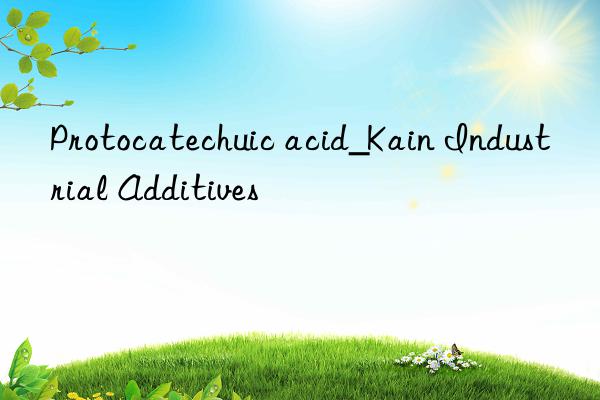
Protocatechuic acid has antibacterial effects. In in vitro tests, it was effective against Pseudomonas aeruginosa, Escherichia coli, Typhoid bacilli, and dysentery. Bacillus, Alcaligenes, Bacillus subtilis and Staphylococcus aureus all have varying degrees of antibacterial effects. It also has the effect of eliminating phlegm and relieving asthma. Clinically used to treat chronic tracheitis.
The LD50 of protocatechuic acid injection for intravenous injection is 3.485±0.214g/kg. Symptoms of poisoning include listlessness, motionless posture, and significantly accelerated breathing. Before death, a series of poisoning symptoms caused by hypoxia occur: shortness of breath, twitching of limbs, incontinence of urine and feces, etc.
Protocatechuic acid has the following applications in the market:
Antibacterial effect
Protocatechuic acid has inhibitory effects on white and Staphylococcus aureus, Streptococcus pneumoniae, Streptococcus A, Haemophilus influenzae, Pseudomonas aeruginosa, Escherichia coli, and Proteus. Staphylococcus aureus infection in mice reduces mortality by 30%.
Effects on cardiovascular system
2.1 Effect of protocatechuic acid (1) on coronary blood vessels and myocardial oxygen consumption
After intravenous injection of 50 mg/kg protocatechuic acid in cats, the coronary sinus flow did not change significantly. However, 15 minutes after administration, oxygen consumption decreased by about 47%. The blood pressure first increased slightly, then decreased briefly, and then returned to normal, and the heart rate did not change. Change. When intravenous injection of epinephrine was given 15 minutes after intravenous injection of protocatechuic acid, the degree of increase in coronary sinus flow 1 minute later was not significantly different from that in the epinephrine alone group, but the oxygen consumption only increased by 80%, which was higher than that in the epinephrine alone (consumption Compared with 100% increase in oxygen content, the difference between the two is very significant, indicating that protocatechuic acid can partially resist the increase in myocardial oxygen consumption caused by epinephrine. In another experiment, it was also found that protocatechuic acid 50mg/kg was injected intravenously followed by protocatechuic aldehyde 10mg/kg, proving that protocatechuic acid can partially counteract the increase in oxygen consumption caused by protocatechualdehyde. When protocatechuic acid and protocatechuic aldehyde are mixed at 10mg/kg each, the effect of increasing coronary sinus flow is weaker than protocatechuic acid alone at the same dose, and the time is shortened. However, it is superior to protocatechuic aldehyde alone in reducing arterial and venous oxygen difference and reducing myocardial oxygen consumption. After intravenous injection of the mixed solution, blood pressure first drops briefly, then rises weakly and persistently, increases blood flow in the pancreas, portal vein and lungs, and accelerates heart rate; blood flow in the hepatic artery and renal artery decreases.
2.2 Effect on myocardial resistance to hypoxia
The rat cardiopulmonary perfusion hypoxia test method was used to directly measure the hypoxia tolerance of rat myocardium. It was observed that the myocardial hypoxia tolerance time was significantly prolonged after intravenous injection of 10 mg of protocatechuic acid, but the prolongation of myocardial hypoxia tolerance was longer than that of B. Aminocoumarins are slightly less effective. 3 minutes after administration, cardiac output increased by 10%. It can be seen that protocatechuic acid can significantly extend the time myocardium can withstand hypoxia while mildly improving cardiac function. At the same time, it can also reduce the drop in blood pressure caused by hypoxia. Slowing down the heart rate is beneficial to prolonging the myocardial hypoxia resistance time. The normal pressure and hypoxia tolerance experiment proved that protocatechuic acid can prolong the survival time of mice (maintaining it for more than 1 and a half hours), which is similar to the effect of dipyridamole at the same dose.
2.3 Effect on the heart and peripheral blood vessels
After intravenous injection of protocatechuic acid, coronary resistance gradually decreases, lasting about 30 minutes, and returns to the original level after about 1 hour. During this period, systemic blood pressure slightly increases. Protocatechuic acid has a dilating effect on the blood vessels of the hind limbs in cats but has no obvious change in dogs. The mixture of protocatechuic acid and protocatechuic aldehyde exhibits a slow and mild pressor effect, which can dilate the blood vessels of the lower limbs of animals, but the splenic vascular reaction is slight, which can illustrate the relationship between the pressor effect and changes in peripheral and certain visceral blood vessels. Not large, so it has nothing to do with α-receptor excitation.
Expectant effect
Protocatechuic acid 4.68mg/mouse was orally administered to show the expectorant effect.
Antiasthmatic effect
Guinea pig histamine spray asthma test proved that protocatechuic acid has obvious anti-asthmatic effect.
Snake venom detoxification
Protocatechuic acid has a significant protective effect against cobra poisoning in mice.
Other functions
Protocatechuic acid has a significant inhibitory effect on "formaldehyde-induced swollen feet" in mice, and the effect is stronger than that of salicylic acid and close to acetylsalicylic acid. It also has a temporary inhibitory effect on "formaldehyde foot swelling" in rats. The excretion of 17-hydroxysteroids in the urine can temporarily increase, and it is also effective on rats with adrenalectomy. Mixing 0.2% protocatechuic acid into guinea pig feed can significantly inhibit the occurrence of dental caries. This effect may be related to its inhibitory effect on oral microorganisms. Protocatechuic acid has a mild inhibitory effect on experimental HF sarcoma and sarcoma 180 in mice.
Processes in the body
Rats take it orally or intraperitoneally. After rabbits take it orally, protocatechuic acid can be excreted unchanged or methylated to form vanillic acid (Va-nillic acid) and excreted in the urine. After oral administration, protocatechuic acid can also be decarboxylated to form catechol. Oxytetracycline or neomycin significantly reduces or eliminates the decarboxylation reaction. Protocatechuic acid injection, after intravenous injection into rabbit blood, is excreted in the urine within the first 4 hours after administration; within 4 to 8 hours after administration, the amount of excretion is greatly reduced; after 8 hours of administration, the amount of excretion is extremely small , some rabbits have no detectable drug content in their urine.
Reference materials: https://chanpin.chem960.com/4787252/
https://www.baike.com/wiki/Protocatechuic acid



 微信扫一扫打赏
微信扫一扫打赏
